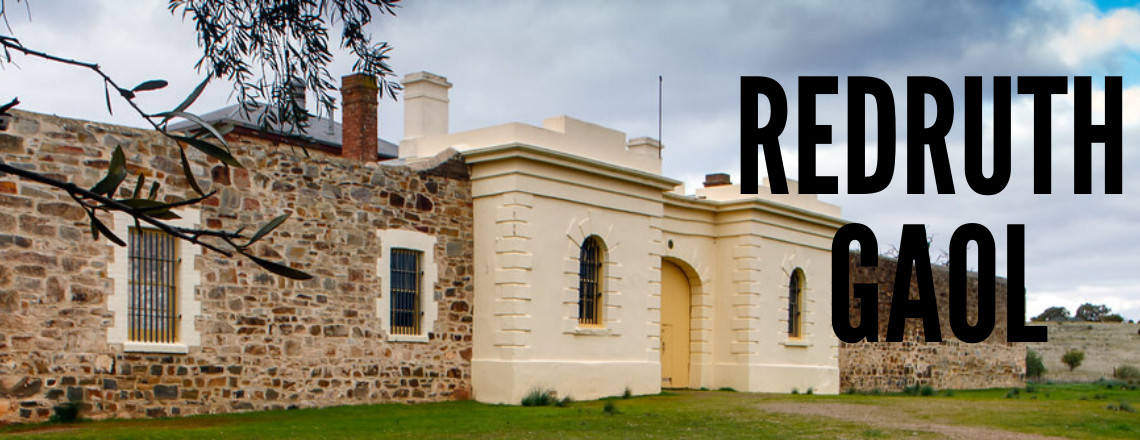
Redruth Gaol
Redruth Gaol erected in 1856 was the first gaol in South Australia outside of Adelaide. So why did Burra, or Kooringa as it was known back then, need a gaol in the middle of a mining village?
Life was tough for the miners during the copper mining era in Burra. Disputes occurred on a regular basis, due in part to the excessive consumption of alcohol. During the hours of 5am and 11pm, miners as young as 12 could visit the hotels to enjoy a drink or two after a hard day at the mines.
Intoxication and vandalism were significant causes of overcrowding in the police station lock up. Thomas Perry, the gaoler at the police cells, complained about the overcrowded cells to the Presiding Magistrate, subsequently, it was decided that a gaol was required. The South Australian Mining Company owned the majority of the land in Kooringa, so government land was sourced outside Kooringa to build Redruth Prison, the first gaol in South Australia to be opened outside of Adelaide.
Constructed in 1856, at the cost of £3200, the gaol housed thirty prisoners whose offences included drunkenness, vandalism and debt. Three cells for females and three for males, together with separate exercise yards and a workroom, became home at “Perry’s Hotel” as it was known, for prisoners sentenced to hard labour inside the broken glass topped walls. Thomas Perry was the gaoler at Redruth for over 23 years, residing with his family in the prison, along with a turnkey and a warden.
Information signs are located throughout the building, including a list of the names, crimes and sentences of those who passed through the local judicial system. The crimes varied from minor misdemeanours to inmates who had committed serious crimes such as murder. One boy was sentenced to one-month hard labour for breaking a window in Paxton Square and others were sentenced for crimes including deserting a ship, deserting family and even using bad language.
The doctor’s journal is also an interesting read, one prisoner diagnosed as being “silly – a little”, and another for being “unable to walk to Adelaide”. The displays and signs provide an insight into life for the prisoners until they were transported to Gladstone prison when the gaol was closed in 1894.
Thomas and Catherine Woollacott became the first of three families to reside in the building, from around 1894 to 1897. Several of their ten children were born at Redruth.
After renovations the gaol reopened as the Hampton Court Girls Reformatory, a government detention centre for delinquent Protestant girls aged 15 years and older. In January 1898, the resident matron, Mary Elizabeth Holden, and 30 of the unruliest girls were transferred from Edwardstown to the Redruth site.
In Mary Holden’s eleven-year tenure she attempted to make the reformatory more civilised by installing running water, establishing gardens and running sheep and cattle on the property. Life at the reformatory was not easy; the girls slept in wards and were employed in a variety of jobs such as sewing, and taking in washing and ironing, as well as looking after the livestock.
Following Mary Holden’s retirement in 1909, Elizabeth Price arrived from the Catholic Girls’ Reformatory in Kapunda, which had recently closed. The new matron brought 11 girls from Kapunda with her to live at Redruth. Elizabeth Price was fond of corporal punishment, which had been forbidden in female institutions.
Although no prisoners had managed to escape from Redruth, the girls made forty escape attempts, two escapees were found over 70 kms from the reformatory. The girls also started a fire which destroyed the laundry.
By the time the reformatory closed in 1922, Edith Bubb was the residing matron. The government decided that the gaol was no longer a suitable building to house the girls, possibly because of the troubling events including riots and girls climbing on the gaol roof. The girls were transferred to Barton Vales Girls Home. The display boards in the building provide details of the escapes and trouble caused by the girls.
Before becoming a museum managed by the National Trust, the Redruth Gaol building was home to the Todd family and the Baxter family. Interesting interviews with members from these families are on display in the gaol for visitors to read. The building became famous during the shooting of the movie Breaker Morant starring Edward Woodward, Bryan Brown and Jack Thomson.
